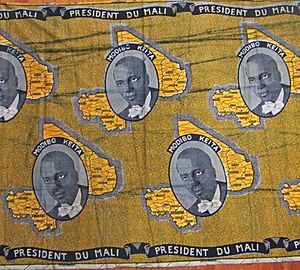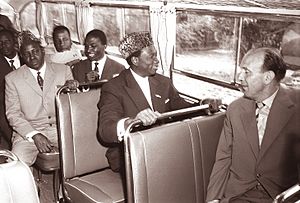Modibo Keïta facts for kids
Quick facts for kids
Modibo Keïta
|
|
|---|---|
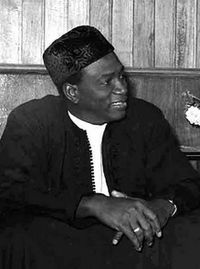
Keïta in 1966
|
|
| 1st President of Mali | |
| In office July 20 1960 – 19 November 1968 |
|
| Preceded by | Office established |
| Succeeded by | Moussa Traoré |
| President of Mali Federation | |
| In office January 1959 – July 20 1960 |
|
| Preceded by | Office Established |
| Succeeded by | Office abolished |
| Personal details | |
| Born | 4 June 1915 Bamako Coura, Upper Senegal and Niger |
| Died | 16 May 1977 (aged 61) Bamako, Mali |
| Nationality | French, since 1960: Malian |
| Political party | Sudanese Union-African Democratic Rally |
| Spouses | Polygamous with 3 wives
Mariam Travélé
(m. 1939)Fatoumata "Didi" Haïdara
(m. 1952; died 1976)
|
Modibo Keïta (born June 4, 1915 – died May 16, 1977) was an important leader from Mali. He became the very first President of Mali in 1960. He led the country until 1968. Keïta believed in a special kind of government called African socialism. This meant the government would control many parts of the economy to help everyone.
He was born and grew up in Bamako, the capital city of Mali. Before becoming a politician, he worked as a teacher. This was when Mali was still ruled by France. In 1945, he helped start a political group called the Sudanese Union. This group later joined with others to form the African Democratic Rally. Keïta became very well known in politics during the 1950s.
In 1959, he became the Prime Minister of the Mali Federation. This was a short-lived union between Mali and Senegal. When this union ended in 1960, Mali became an independent country. Modibo Keïta then became its first president.
As president, he made his political group, the US-RDA, the only official party. He started to put his socialist ideas into action. This included the government taking control of many businesses. In foreign affairs, he wanted Mali to be friends with all countries. He supported the Non-Aligned Movement. This group of countries did not take sides with the USA or the Soviet Union during the Cold War. Keïta also worked hard for unity among African nations. He helped create the Organization of African Unity. He also helped end a conflict between Morocco and Algeria.
However, people in Mali became unhappy in the late 1960s. The economy was getting worse. Keïta also dealt with people who disagreed with him very strictly. In 1968, he was removed from power by a military takeover. This was led by Moussa Traoré. Keïta was sent to prison and died there in 1977.
Contents
Early Life and Education
Modibo Keïta was born in Bamako-Coura. This was a neighborhood in Bamako, the capital of French Sudan at the time. His family were Malian Muslims. They said they were direct descendants of the Keita dynasty. This was a powerful family that founded the old Mali Empire.
When he was a child, his nickname was Modo. He went to school in Bamako. He also studied at the famous École normale supérieure William Ponty in Dakar. He was the best student in his class there. In 1936, he started working as a teacher. He taught in Bamako, Sikasso, and Tombouctou. In September 1939, he married Mariam Travélé, who was also a teacher.
Starting in Politics
Modibo Keïta was involved in many groups. In 1937, he helped lead an art and theater group. He also helped start the Union of French West African Teachers. This showed his early interest in working with others.
Keïta joined a group in Bamako called the Communist Study Groups. In 1943, he started a magazine called L'oeil de Kénédougou. This magazine openly criticized the French colonial rule. Because of this, he was put in prison for three weeks in Paris in 1946.
In 1945, Keïta ran for a position in the French government. Later that year, he and Mamadou Konaté created a group called the Bloc soudanais. This group grew and became the Sudanese Union.
Becoming a National Leader
In October 1946, a big meeting happened in Bamako. Delegates from all over French Africa came together. They created the African Democratic Rally (RDA). Félix Houphouët-Boigny led this group. Keïta became the Secretary-General of the RDA in French Sudan. He also led its local branch, the US-RDA.
In 1948, he was elected as a general councilor for French Sudan. In 1956, he became the mayor of Bamako. He also became a member of the French National Assembly in France. He worked as a secretary of state in the French government twice.
Modibo Keïta became the premier of the Mali Federation in 1959. On July 20, 1960, he was elected president of the federation's assembly. This federation included French Sudan and Senegal. However, Senegal later left the federation.
President of Mali
After the Mali Federation broke apart, French Sudan declared its full independence. It became the Republic of Mali. Keïta became Mali's first president. Soon after, he announced that his party, the US-RDA, was the only legal political party.
As a socialist, he wanted the government to control more of the economy. He started with farming and trade. In October 1960, he created SOMIEX. This was a company that controlled all of Mali's exports. It also controlled imports of important goods like sugar and tea. This system led to problems. The Malian franc was created in 1962. This, along with supply issues, caused prices to rise a lot. Many people, especially farmers and business owners, became unhappy.
The government also tried to stop slavery, which still existed in some areas.
In June 1961, Keïta visited the United Kingdom. Queen Elizabeth II made him an honorary Knight. Even though the United States was careful about his socialist views, Keïta wanted good relations. In September 1961, he visited America with Sukarno. He met with President John F. Kennedy. Keïta felt that Kennedy was a friend.
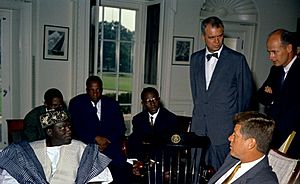
Keïta also helped solve a conflict between Morocco and Algeria. This was known as the Sand War. He tried to form a union between Ghana and Guinea. He also worked hard to improve relations with Senegal. He won the Lenin Peace Prize for his efforts.
However, Mali faced many financial problems. A very bad harvest in 1968 made things worse. This led to a military takeover later that year.
Politically, Modibo Keïta quickly put opponents in prison. In the 1964 elections, only candidates from his US-RDA party were allowed to run. Keïta was re-elected president. From 1967, he started a "revolution active." He suspended the constitution and created a special committee to defend the revolution. The actions of his party's militia and the devaluation of the Malian franc in 1967 caused widespread unrest.
On November 19, 1968, General Moussa Traoré led a military coup. He overthrew Modibo Keïta and sent him to prison in Kidal, a town in northern Mali.
Modibo Keïta was moved back to Bamako in February 1977. This was said to be a step towards his release. However, he died in prison on May 16, 1977. His good name was restored in 1992. This happened after Moussa Traoré was overthrown and new elections were held. A monument to Modibo Keïta was built in Bamako on June 6, 1999.
Working for African Unity
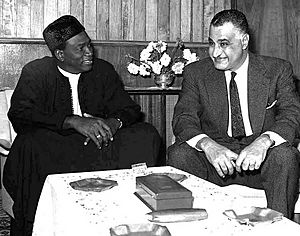
Modibo Keïta spent his life working for African unity. He first helped create the Mali Federation with Léopold Sédar Senghor. After it broke apart, he worked with Ahmed Sékou Touré, the president of Guinea, and Kwame Nkrumah, the president of Ghana. They formed the Union of the States of Western Africa. In 1963, he played a big part in writing the rules for the Organization of African Unity (OAU).
In 1963, he invited the king of Morocco and the president of Algeria to Bamako. He hoped to end the Sand War, a border conflict between their countries. With Haile Selassie, the Emperor of Ethiopia, Keïta successfully helped negotiate the Bamako Accords. This agreement ended the conflict. Because of this, he won the Lenin Peace Prize that year.
From 1963 to 1966, he improved Mali's relations with Senegal, Upper Volta, and Côte d'Ivoire. Keïta also supported groups fighting for independence, like the Algerian National Liberation Front. He was a strong supporter of the Non-Aligned Movement.
|
See also
 In Spanish: Modibo Keïta para niños
In Spanish: Modibo Keïta para niños


